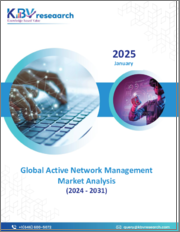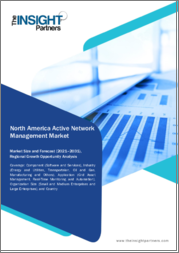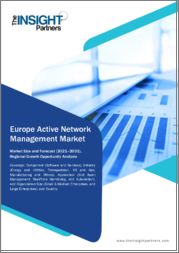
|
시장보고서
상품코드
1602386
세계의 액티브 네트워크 관리 시장 : 컴포넌트별, 조직 규모별, 용도별 - 예측(2025-2030년)Active Network Management Market (ANM) by Component (Services, Software), Organization Size (Large Enterprises, Small & Medium-Sized Enterprises), Application - Global Forecast 2025-2030 |
||||||
액티브 네트워크 관리 시장의 2023년 시장 규모는 12억 4,000만 달러로 평가되었고, 2024년에는 14억 달러로 추정되며, CAGR 13.26%로 성장할 전망이고, 2030년에는 29억 8,000만 달러에 이를 것으로 예측됩니다.
액티브 네트워크 관리는 발전, 저장 및 부하와 같은 에너지 시스템 구성 요소를 조정하고 효율성과 신뢰성을 최적화하는 것이며 주로 스마트 그리드에 있는 것입니다. 액티브 네트워크 관리의 필요성은 신재생 에너지원의 보급 확대, 분산형 에너지 생산, 에너지 수요가 높아지는 가운데 계통 회복력의 필요성에서 발생하고 있습니다.액티브 네트워크 관리의 용도는 공익사업에서 에너지 관리, 분산형 발전, 마이크로그리드, EV충전 네트워크 등 다방면에 걸칩니다. 최종 용도로는 전력회사, 산업용 전력 소비자, 분산형 에너지 자원(DER)을 활용하는 주택 등이 포함됩니다. 주요 성장 요인으로는 IoT와 AI의 기술적 진보, 스마트 인프라에 대한 규제 지원, 스마트 그리드 기술에 대한 투자 증가 등이 있습니다. 비즈니스 기회는 에너지 배급의 예측 유지보수와 최적화를 위한 AI 주도형 분석 통합, 맞춤형 에너지 솔루션 제공, 다양한 그리드 구성 요소 간의 상호 운용성 향상에 있습니다. 아시아태평양과 북미는 현저한 기술 혁신과 정부의 지원 정책으로 고성장 시장이 될 것으로 예측됩니다. 한계로는 초기 설비투자 과제, 레거시 시스템과 신기술의 통합 복잡성, 사이버 보안 위협 등을 들 수 있습니다. 또한 규제 장벽이나 지역 간 표준화 문제는 균일한 채택을 방해할 가능성이 있습니다. 혁신을 위해서는 에너지 거래의 안전한 트랜잭션을 위한 블록체인 개발 및 서로 다른 그리드 크기와 유형에 쉽게 적응할 수 있는 모듈식으로 확장 가능한 ANM 솔루션 구축을 위한 연구를 수행할 수 있습니다. 사이버 보안 우려에 대해서는 견고한 프레임워크와 보다 유연한 규제 도입을 도입함으로써 보급을 더욱 확실하게 할 수 있습니다. 전체적으로 시장은 지속 가능한 에너지 동향과 에너지 관리에 있어서 디지털 변혁에 힘입어 효율성과 신뢰성을 겸비한 분산형이면서 통합된 에너지 네트워크의 구축에 초점을 맞춘 역동적인 것이 되고 있습니다.
| 주요 시장 통계 | |
|---|---|
| 기준년(2023년) | 12억 4,000만 달러 |
| 예측년(2024년) | 14억 달러 |
| 예측년(2030년) | 29억 8,000만 달러 |
| CAGR(%) | 13.26% |
시장 역학 : 빠르게 진화하는 액티브 네트워크 관리 시장의 주요 시장 인사이트 공개
액티브 네트워크 관리 시장은 수요 및 공급의 역동적인 상호 작용에 의해 변모를 이루고 있습니다. 이러한 시장 역학의 진화를 이해함으로써 기업은 충분한 정보를 바탕으로 투자결정, 전략적 의사결정, 새로운 비즈니스 기회를 획득할 수 있습니다. 이러한 동향을 종합적으로 파악함으로써 기업은 정치적, 지리적, 기술적, 사회적, 경제적인 영역에 걸친 다양한 리스크를 경감할 수 있음과 동시에, 소비자 행동과 그것이 제조 비용이나 구매 동향에 미치는 영향을 보다 명확하게 이해할 수 있습니다.
- 시장 성장 촉진요인
- 소비자의 무정전 전력에 대한 수요 증가와 효율적인 전력 관리 솔루션의 필요성
- 신재생 에너지의 상업화 성장
- 스마트 그리드 기기 및 시스템에 대한 투자 확대
- 시장 성장 억제요인
- 자본 집약적인 도입 프로세스
- 시장 기회
- 에너지 분야에서의 스마트 IoT 접속 디바이스의 채용 증가
- 스마트시티 개발에 대한 민간 및 공공투자 증가
- 시장의 과제
- 스마트 그리드 기술과 기존 시스템과의 호환성 문제
Porter's Five Forces : 액티브 네트워크 관리 시장을 탐색하는 전략 도구
Porter's Five Forces 프레임워크는 시장 상황의 경쟁 구도를 파악하는 중요한 도구입니다. Porter's Five Forces 프레임워크는 기업의 경쟁력을 평가하고 전략적 기회를 탐구하는 명확한 기술을 제공합니다. 이 프레임워크는 기업이 시장 내 세력도를 평가하고 신규 사업의 수익성을 판단하는 데 도움이 됩니다. 이러한 인사이트를 통해 기업은 자사의 강점을 활용하고, 약점을 해결하고, 잠재적인 과제를 피할 수 있으며, 보다 강인한 시장에서의 포지셔닝을 보장할 수 있습니다.
PESTLE 분석 : 액티브 네트워크 관리 시장에서 외부 영향 파악
외부 거시 환경 요인은 액티브 네트워크 관리 시장의 성과 역학을 형성하는 데 매우 중요한 역할을 합니다. 정치적, 경제적, 사회적, 기술적, 법적, 환경적 요인 분석은 이러한 영향을 탐색하는 데 필요한 정보를 제공합니다. PESTLE 요인을 조사함으로써 기업은 잠재적인 위험과 기회를 더 잘 이해할 수 있습니다. 이 분석을 통해 기업은 규제, 소비자 선호, 경제 동향의 변화를 예측하고 앞으로 예상되는 적극적인 의사 결정을 할 준비를 할 수 있습니다.
시장 점유율 분석 : 액티브 네트워크 관리 시장 경쟁 구도 파악
액티브 네트워크 관리 시장의 상세한 시장 점유율 분석을 통해 공급업체의 성과를 종합적으로 평가할 수 있습니다. 기업은 수익, 고객 기반, 성장률 등 주요 지표를 비교하여 경쟁 포지셔닝을 밝힐 수 있습니다. 이 분석을 통해 시장 집중, 단편화, 통합 동향을 밝혀내고 벤더들은 경쟁이 치열해지는 가운데 자사의 지위를 높이는 전략적 의사 결정을 내리는 데 필요한 지식을 얻을 수 있습니다.
FPNV 포지셔닝 매트릭스 : 액티브 네트워크 관리 시장에서 공급업체의 성능 평가
FPNV 포지셔닝 매트릭스는 액티브 네트워크 관리 시장에서 벤더를 평가하는 중요한 도구입니다. 이 메트릭스를 통해 비즈니스 조직은 공급업체의 비즈니스 전략과 제품 만족도를 기준으로 평가하여 목표에 맞는 충분한 정보를 바탕으로 의사 결정을 내릴 수 있습니다. 네 가지 사분면을 통해 공급업체를 명확하고 정확하게 부문화하고 전략 목표에 가장 적합한 파트너 및 솔루션을 파악할 수 있습니다.
전략 분석 및 추천 : 액티브 네트워크 관리 시장에서 성공을 위한 길을 그리기
액티브 네트워크 관리 시장의 전략 분석은 세계 시장에서의 프레즌스 강화를 목표로 하는 기업에 필수적인 요소입니다. 주요 자원, 능력 및 성과 지표를 검토함으로써 기업은 성장 기회를 파악하고 개선을 위해 노력할 수 있습니다. 이러한 접근 방식을 통해 경쟁 구도에서 과제를 극복하고 새로운 비즈니스 기회를 활용하여 장기적인 성공을 거둘 수 있는 체제를 구축할 수 있습니다.
이 보고서는 주요 관심 분야를 포괄하는 시장의 종합적인 분석을 제공합니다.
1. 시장 침투 : 현재 시장 환경의 상세한 검토, 주요 기업의 광범위한 데이터, 시장 도달범위 및 전반적인 영향력을 평가합니다.
2. 시장 개척도 : 신흥 시장의 성장 기회를 파악하고 기존 분야의 확장 가능성을 평가하며 미래 성장을 위한 전략적 로드맵을 제공합니다.
3. 시장 다양화 : 최근 제품 출시, 미개척 지역, 업계의 주요 진보, 시장을 형성하는 전략적 투자를 분석합니다.
4. 경쟁 평가 및 정보 : 경쟁 구도를 철저히 분석하여 시장 점유율, 사업 전략, 제품 포트폴리오, 인증, 규제 당국 승인, 특허 동향, 주요 기업의 기술 진보 등을 검증합니다.
5. 제품 개발 및 혁신 : 미래 시장 성장을 가속할 것으로 예상되는 최첨단 기술, 연구개발 활동, 제품 혁신을 강조합니다.
또한 이해관계자가 충분한 정보를 얻고 의사결정을 할 수 있도록 중요한 질문에 대답하고 있습니다.
1. 현재 시장 규모 및 향후 성장 예측은?
2. 최고의 투자 기회를 제공하는 제품, 부문 및 지역은 어디입니까?
3. 시장을 형성하는 주요 기술 동향 및 규제의 영향은?
4. 주요 벤더의 시장 점유율 및 경쟁 포지션은?
5. 벤더 시장 진입 및 철수 전략의 원동력이 되는 수익원과 전략적 기회는 무엇인가?
목차
제1장 서문
제2장 조사 방법
제3장 주요 요약
제4장 시장 개요
제5장 시장 인사이트
- 시장 역학
- 성장 촉진요인
- 소비자의 무정전 전력 수요 증가와 효율적인 전력 관리 솔루션의 필요성
- 신재생 에너지의 상업화 확대
- 스마트 그리드 기기 및 시스템에 대한 투자 증가
- 억제요인
- 자본 집약적인 도입 프로세스
- 기회
- 에너지 분야에서의 스마트 IoT 접속 디바이스의 채용 증가
- 스마트시티 개발에 대한 민간 및 공공투자 증가
- 과제
- 스마트 그리드 기술과 기존 시스템 간의 호환성 문제
- 성장 촉진요인
- 시장 세분화 분석
- Porter's Five Forces 분석
- PESTEL 분석
- 정치적
- 경제
- 사교
- 기술적
- 법률상
- 환경
제6장 액티브 네트워크 관리 시장 : 컴포넌트별
- 서비스
- 매니지드 서비스
- 전문적인 서비스
- 컨설팅
- 지원 및 유지 보수
- 시스템 통합
- 소프트웨어
제7장 액티브 네트워크 관리 시장 : 조직 규모별
- 대기업
- 중소기업
제8장 액티브 네트워크 관리 시장 : 용도별
- 재생 불가능한 에너지
- 신재생 에너지
제9장 아메리카의 액티브 네트워크 관리 시장
- 아르헨티나
- 브라질
- 캐나다
- 멕시코
- 미국
제10장 아시아태평양의 액티브 네트워크 관리 시장
- 호주
- 중국
- 인도
- 인도네시아
- 일본
- 말레이시아
- 필리핀
- 싱가포르
- 한국
- 대만
- 태국
- 베트남
제11장 유럽, 중동 및 아프리카의 액티브 네트워크 관리 시장
- 덴마크
- 이집트
- 핀란드
- 프랑스
- 독일
- 이스라엘
- 이탈리아
- 네덜란드
- 나이지리아
- 노르웨이
- 폴란드
- 카타르
- 러시아
- 사우디아라비아
- 남아프리카
- 스페인
- 스웨덴
- 스위스
- 터키
- 아랍에미리트(UAE)
- 영국
제12장 경쟁 구도
- 시장 점유율 분석(2023년)
- FPNV 포지셔닝 매트릭스(2023년)
- 경쟁 시나리오 분석
- 전략 분석 및 제안
기업 목록
- ABB Ltd.
- Argand Solutions Ltd.
- Camlin Limited
- Chemtrols Industries Pvt. Ltd
- Chetu, Inc.
- Cisco Systems, Inc.
- Dhyan Networks and Technologies Inc.
- DNV AS
- Electronic Specifier Ltd.
- Fortra LLC
- General Electric Company
- International Business Machines Corporation
- Intrada Technologies
- Itron Inc.
- Landis Gyr AG
- Mitsubishi Electric Corporation
- NAAC Energy Controls Pvt. Limited
- National Grid Electricity Distribution PLC
- Operation Technology, Inc.
- Oracle Corporation
- Pacific Controls Smart Grid Services Inc.
- Roadnight Taylor Ltd.
- Schneider Electric SE
- Scottish and Southern Electricity Networks
- Siemens AG
- SolarWinds Worldwide, LLC
- Weidmuller Interface GmbH & Co. KG
- Zenoss, Inc.
- ZIV Aplicaciones y Tecnologia, SL
- Zoho Corporation Pvt. Ltd.
The Active Network Management Market was valued at USD 1.24 billion in 2023, expected to reach USD 1.40 billion in 2024, and is projected to grow at a CAGR of 13.26%, to USD 2.98 billion by 2030.
Active Network Management (ANM) refers to the coordinated control of energy system components like generation, storage, and load to optimize efficiency and reliability, primarily within smart grids. The necessity for ANM arises from the growing penetration of renewable energy sources, decentralized energy production, and the need for grid resilience amidst mounting energy demands. Applications of ANM span across energy management in utilities, distributed generation, microgrids, and EV charging networks. End-use includes utility companies, industrial power consumers, and residential setups leveraging distributed energy resources (DER). Key growth factors include technological advancements in IoT and AI, regulatory support for smart infrastructure, and increasing investments in smart grid technology. Opportunities lie in the integration of AI-driven analytics for predictive maintenance and optimization of energy distribution, providing customized energy solutions, and enhancing interoperability between diverse grid components. Asia-Pacific and North America are projected to be high-growth markets due to significant technological innovations and supportive government policies. Limitations include the challenges of initial capital investment, the complexity of integrating legacy systems with new technologies, and cyber-security threats. Moreover, regulatory hurdles and standardization issues across different regions can impede uniform adoption. For innovation, research can be directed towards the development of blockchain for secure transactions in energy trading and the creation of modular, scalable ANM solutions that can be easily adapted to different grid sizes and types. Addressing the cybersecurity concern with robust frameworks and the introduction of more flexible regulatory compliances can further ensure widespread adoption. Overall, the market is dynamic, underpinned by sustainable energy trends and digital transformation in energy management, with a focus on creating a distributed, yet integrated energy network that is both efficient and reliable.
| KEY MARKET STATISTICS | |
|---|---|
| Base Year [2023] | USD 1.24 billion |
| Estimated Year [2024] | USD 1.40 billion |
| Forecast Year [2030] | USD 2.98 billion |
| CAGR (%) | 13.26% |
Market Dynamics: Unveiling Key Market Insights in the Rapidly Evolving Active Network Management Market
The Active Network Management Market is undergoing transformative changes driven by a dynamic interplay of supply and demand factors. Understanding these evolving market dynamics prepares business organizations to make informed investment decisions, refine strategic decisions, and seize new opportunities. By gaining a comprehensive view of these trends, business organizations can mitigate various risks across political, geographic, technical, social, and economic domains while also gaining a clearer understanding of consumer behavior and its impact on manufacturing costs and purchasing trends.
- Market Drivers
- Increasing demand for uninterruptible electricity from consumers and need for efficient power management solutions
- Growth in commercialization of renewable energy
- Growing investment in smart-grid devices and systems
- Market Restraints
- High capital intensive deployment process
- Market Opportunities
- Increasing adoption of smart IoT connected devices in energy sector
- Increasing private and public investment in development of smart cities
- Market Challenges
- Compatibility issues of smart grid technologies with conventional systems
Porter's Five Forces: A Strategic Tool for Navigating the Active Network Management Market
Porter's five forces framework is a critical tool for understanding the competitive landscape of the Active Network Management Market. It offers business organizations with a clear methodology for evaluating their competitive positioning and exploring strategic opportunities. This framework helps businesses assess the power dynamics within the market and determine the profitability of new ventures. With these insights, business organizations can leverage their strengths, address weaknesses, and avoid potential challenges, ensuring a more resilient market positioning.
PESTLE Analysis: Navigating External Influences in the Active Network Management Market
External macro-environmental factors play a pivotal role in shaping the performance dynamics of the Active Network Management Market. Political, Economic, Social, Technological, Legal, and Environmental factors analysis provides the necessary information to navigate these influences. By examining PESTLE factors, businesses can better understand potential risks and opportunities. This analysis enables business organizations to anticipate changes in regulations, consumer preferences, and economic trends, ensuring they are prepared to make proactive, forward-thinking decisions.
Market Share Analysis: Understanding the Competitive Landscape in the Active Network Management Market
A detailed market share analysis in the Active Network Management Market provides a comprehensive assessment of vendors' performance. Companies can identify their competitive positioning by comparing key metrics, including revenue, customer base, and growth rates. This analysis highlights market concentration, fragmentation, and trends in consolidation, offering vendors the insights required to make strategic decisions that enhance their position in an increasingly competitive landscape.
FPNV Positioning Matrix: Evaluating Vendors' Performance in the Active Network Management Market
The Forefront, Pathfinder, Niche, Vital (FPNV) Positioning Matrix is a critical tool for evaluating vendors within the Active Network Management Market. This matrix enables business organizations to make well-informed decisions that align with their goals by assessing vendors based on their business strategy and product satisfaction. The four quadrants provide a clear and precise segmentation of vendors, helping users identify the right partners and solutions that best fit their strategic objectives.
Strategy Analysis & Recommendation: Charting a Path to Success in the Active Network Management Market
A strategic analysis of the Active Network Management Market is essential for businesses looking to strengthen their global market presence. By reviewing key resources, capabilities, and performance indicators, business organizations can identify growth opportunities and work toward improvement. This approach helps businesses navigate challenges in the competitive landscape and ensures they are well-positioned to capitalize on newer opportunities and drive long-term success.
Key Company Profiles
The report delves into recent significant developments in the Active Network Management Market, highlighting leading vendors and their innovative profiles. These include ABB Ltd., Argand Solutions Ltd., Camlin Limited, Chemtrols Industries Pvt. Ltd, Chetu, Inc., Cisco Systems, Inc., Dhyan Networks and Technologies Inc., DNV AS, Electronic Specifier Ltd., Fortra LLC, General Electric Company, International Business Machines Corporation, Intrada Technologies, Itron Inc., Landis+Gyr AG, Mitsubishi Electric Corporation, NAAC Energy Controls Pvt. Limited, National Grid Electricity Distribution PLC, Operation Technology, Inc., Oracle Corporation, Pacific Controls Smart Grid Services Inc., Roadnight Taylor Ltd., Schneider Electric SE, Scottish and Southern Electricity Networks, Siemens AG, SolarWinds Worldwide, LLC, Weidmuller Interface GmbH & Co. KG, Zenoss, Inc., ZIV Aplicaciones y Tecnologia, S.L., and Zoho Corporation Pvt. Ltd..
Market Segmentation & Coverage
This research report categorizes the Active Network Management Market to forecast the revenues and analyze trends in each of the following sub-markets:
- Based on Component, market is studied across Services and Software. The Services is further studied across Managed Services and Professional Service. The Professional Service is further studied across Consulting, Support & Maintenance, and System Integration.
- Based on Organization Size, market is studied across Large Enterprises and Small & Medium-Sized Enterprises.
- Based on Application, market is studied across Non-renewable Energy and Renewable Energy.
- Based on Region, market is studied across Americas, Asia-Pacific, and Europe, Middle East & Africa. The Americas is further studied across Argentina, Brazil, Canada, Mexico, and United States. The United States is further studied across California, Florida, Illinois, New York, Ohio, Pennsylvania, and Texas. The Asia-Pacific is further studied across Australia, China, India, Indonesia, Japan, Malaysia, Philippines, Singapore, South Korea, Taiwan, Thailand, and Vietnam. The Europe, Middle East & Africa is further studied across Denmark, Egypt, Finland, France, Germany, Israel, Italy, Netherlands, Nigeria, Norway, Poland, Qatar, Russia, Saudi Arabia, South Africa, Spain, Sweden, Switzerland, Turkey, United Arab Emirates, and United Kingdom.
The report offers a comprehensive analysis of the market, covering key focus areas:
1. Market Penetration: A detailed review of the current market environment, including extensive data from top industry players, evaluating their market reach and overall influence.
2. Market Development: Identifies growth opportunities in emerging markets and assesses expansion potential in established sectors, providing a strategic roadmap for future growth.
3. Market Diversification: Analyzes recent product launches, untapped geographic regions, major industry advancements, and strategic investments reshaping the market.
4. Competitive Assessment & Intelligence: Provides a thorough analysis of the competitive landscape, examining market share, business strategies, product portfolios, certifications, regulatory approvals, patent trends, and technological advancements of key players.
5. Product Development & Innovation: Highlights cutting-edge technologies, R&D activities, and product innovations expected to drive future market growth.
The report also answers critical questions to aid stakeholders in making informed decisions:
1. What is the current market size, and what is the forecasted growth?
2. Which products, segments, and regions offer the best investment opportunities?
3. What are the key technology trends and regulatory influences shaping the market?
4. How do leading vendors rank in terms of market share and competitive positioning?
5. What revenue sources and strategic opportunities drive vendors' market entry or exit strategies?
Table of Contents
1. Preface
- 1.1. Objectives of the Study
- 1.2. Market Segmentation & Coverage
- 1.3. Years Considered for the Study
- 1.4. Currency & Pricing
- 1.5. Language
- 1.6. Stakeholders
2. Research Methodology
- 2.1. Define: Research Objective
- 2.2. Determine: Research Design
- 2.3. Prepare: Research Instrument
- 2.4. Collect: Data Source
- 2.5. Analyze: Data Interpretation
- 2.6. Formulate: Data Verification
- 2.7. Publish: Research Report
- 2.8. Repeat: Report Update
3. Executive Summary
4. Market Overview
5. Market Insights
- 5.1. Market Dynamics
- 5.1.1. Drivers
- 5.1.1.1. Increasing demand for uninterruptible electricity from consumers and need for efficient power management solutions
- 5.1.1.2. Growth in commercialization of renewable energy
- 5.1.1.3. Growing investment in smart-grid devices and systems
- 5.1.2. Restraints
- 5.1.2.1. High capital intensive deployment process
- 5.1.3. Opportunities
- 5.1.3.1. Increasing adoption of smart IoT connected devices in energy sector
- 5.1.3.2. Increasing private and public investment in development of smart cities
- 5.1.4. Challenges
- 5.1.4.1. Compatibility issues of smart grid technologies with conventional systems
- 5.1.1. Drivers
- 5.2. Market Segmentation Analysis
- 5.3. Porter's Five Forces Analysis
- 5.3.1. Threat of New Entrants
- 5.3.2. Threat of Substitutes
- 5.3.3. Bargaining Power of Customers
- 5.3.4. Bargaining Power of Suppliers
- 5.3.5. Industry Rivalry
- 5.4. PESTLE Analysis
- 5.4.1. Political
- 5.4.2. Economic
- 5.4.3. Social
- 5.4.4. Technological
- 5.4.5. Legal
- 5.4.6. Environmental
6. Active Network Management Market, by Component
- 6.1. Introduction
- 6.2. Services
- 6.2.1. Managed Services
- 6.2.2. Professional Service
- 6.2.2.1. Consulting
- 6.2.2.2. Support & Maintenance
- 6.2.2.3. System Integration
- 6.3. Software
7. Active Network Management Market, by Organization Size
- 7.1. Introduction
- 7.2. Large Enterprises
- 7.3. Small & Medium-Sized Enterprises
8. Active Network Management Market, by Application
- 8.1. Introduction
- 8.2. Non-renewable Energy
- 8.3. Renewable Energy
9. Americas Active Network Management Market
- 9.1. Introduction
- 9.2. Argentina
- 9.3. Brazil
- 9.4. Canada
- 9.5. Mexico
- 9.6. United States
10. Asia-Pacific Active Network Management Market
- 10.1. Introduction
- 10.2. Australia
- 10.3. China
- 10.4. India
- 10.5. Indonesia
- 10.6. Japan
- 10.7. Malaysia
- 10.8. Philippines
- 10.9. Singapore
- 10.10. South Korea
- 10.11. Taiwan
- 10.12. Thailand
- 10.13. Vietnam
11. Europe, Middle East & Africa Active Network Management Market
- 11.1. Introduction
- 11.2. Denmark
- 11.3. Egypt
- 11.4. Finland
- 11.5. France
- 11.6. Germany
- 11.7. Israel
- 11.8. Italy
- 11.9. Netherlands
- 11.10. Nigeria
- 11.11. Norway
- 11.12. Poland
- 11.13. Qatar
- 11.14. Russia
- 11.15. Saudi Arabia
- 11.16. South Africa
- 11.17. Spain
- 11.18. Sweden
- 11.19. Switzerland
- 11.20. Turkey
- 11.21. United Arab Emirates
- 11.22. United Kingdom
12. Competitive Landscape
- 12.1. Market Share Analysis, 2023
- 12.2. FPNV Positioning Matrix, 2023
- 12.3. Competitive Scenario Analysis
- 12.4. Strategy Analysis & Recommendation
Companies Mentioned
- 1. ABB Ltd.
- 2. Argand Solutions Ltd.
- 3. Camlin Limited
- 4. Chemtrols Industries Pvt. Ltd
- 5. Chetu, Inc.
- 6. Cisco Systems, Inc.
- 7. Dhyan Networks and Technologies Inc.
- 8. DNV AS
- 9. Electronic Specifier Ltd.
- 10. Fortra LLC
- 11. General Electric Company
- 12. International Business Machines Corporation
- 13. Intrada Technologies
- 14. Itron Inc.
- 15. Landis+Gyr AG
- 16. Mitsubishi Electric Corporation
- 17. NAAC Energy Controls Pvt. Limited
- 18. National Grid Electricity Distribution PLC
- 19. Operation Technology, Inc.
- 20. Oracle Corporation
- 21. Pacific Controls Smart Grid Services Inc.
- 22. Roadnight Taylor Ltd.
- 23. Schneider Electric SE
- 24. Scottish and Southern Electricity Networks
- 25. Siemens AG
- 26. SolarWinds Worldwide, LLC
- 27. Weidmuller Interface GmbH & Co. KG
- 28. Zenoss, Inc.
- 29. ZIV Aplicaciones y Tecnologia, S.L.
- 30. Zoho Corporation Pvt. Ltd.



















